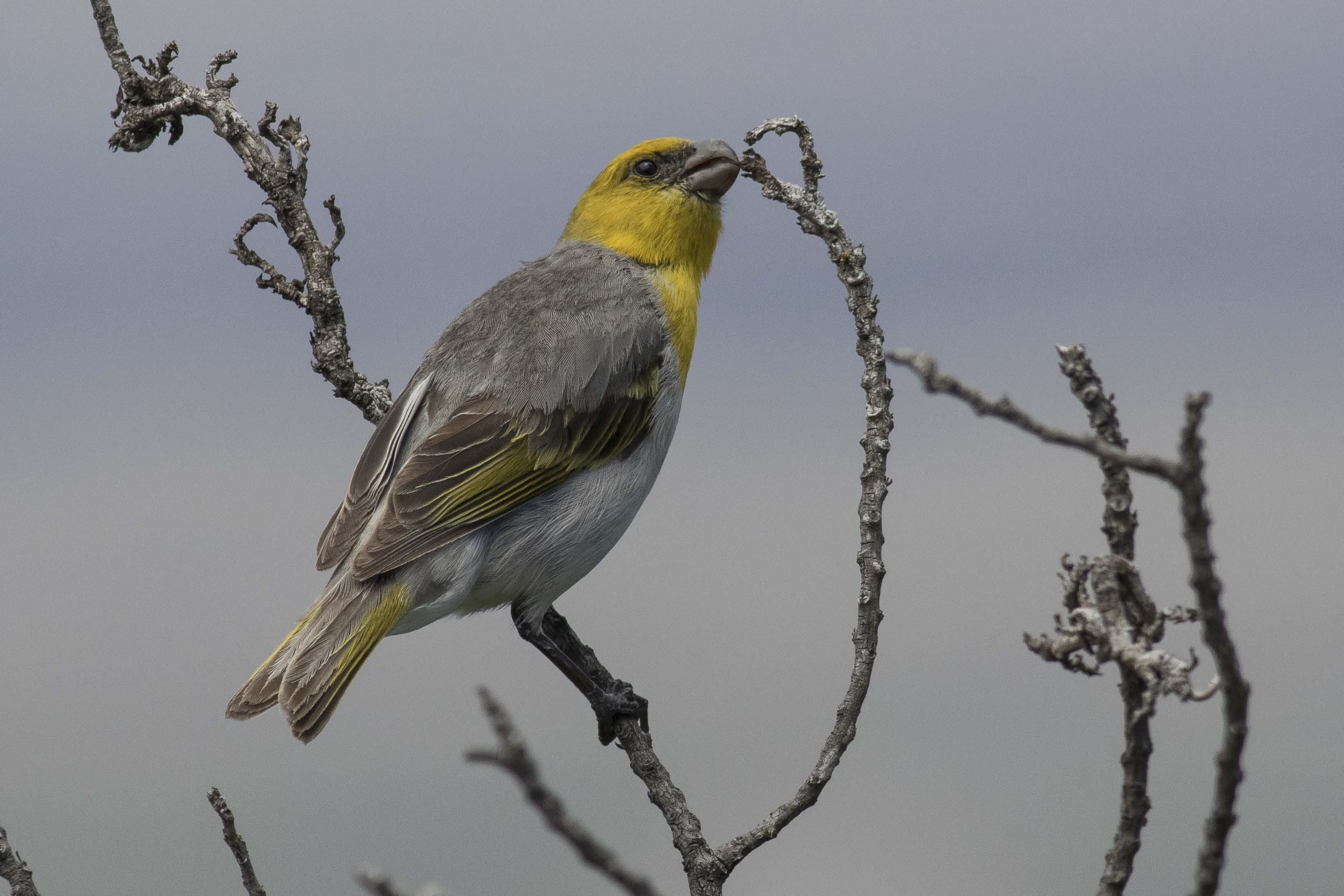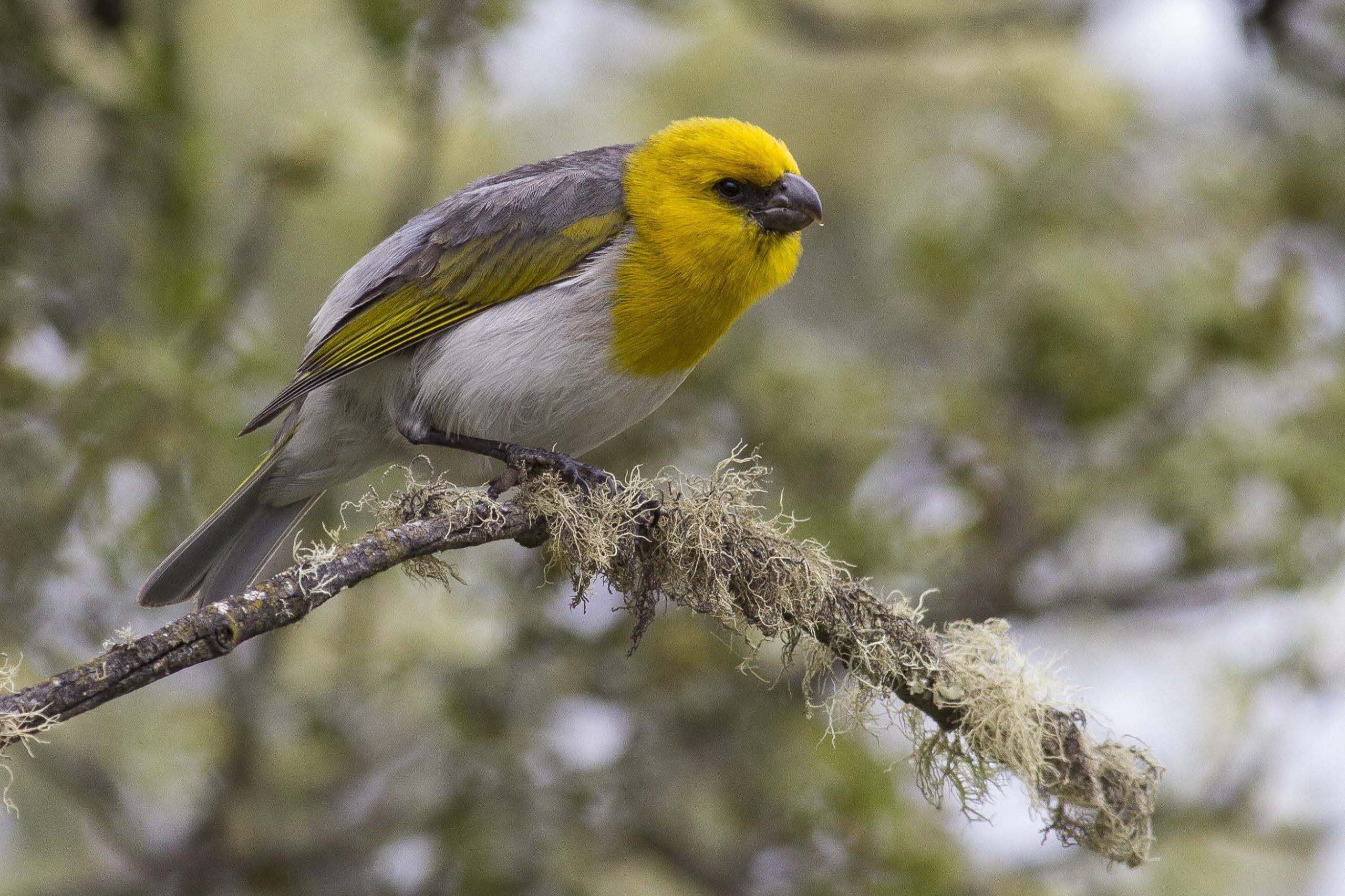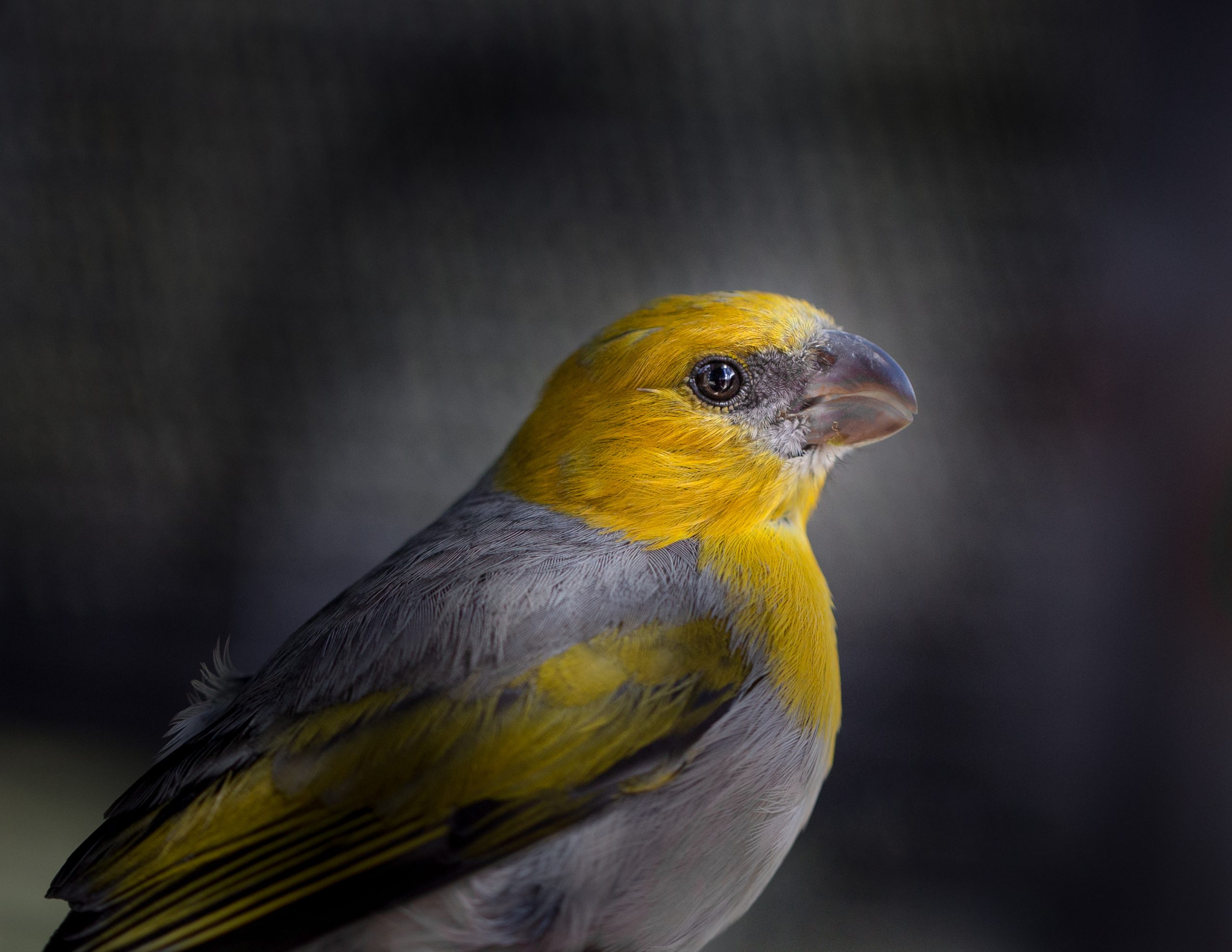Palila
Names
- ʻŌlelo Hawaiʻi: Palila
- Scientific: Loxioides bailleui
Song
Names
- ʻŌlelo Hawaiʻi: Palila
- Scientific: Loxioides bailleui
Conservation Status
- Federally Listed as Endangered
- State Listed as Endangered
- State Recognized as Endemic
- NatureServe Heritage Rank G1—Critically Imperiled
- IUCN Red List Ranking—Critically Endangered
- Revised Recovery Plan for Hawaiian Forest Birds—USFWS 2006
- Critical Habitat Designated 1977
Species Information

Palila. PC: Alex Wang
The palila is a finch-billed Hawaiian honeycreeper (Family: Fringillidae) whose life history and survival is linked to māmane (Sophora chrysophylla), an endemic dry-forest tree in the legume family. Males and females are similar, with a yellow head and breast, greenish wings and tail, a gray back, and white underparts. Males have a black mask, and females have less yellow on the back of their heads and a gray mask. Approximately 90 percent of the palila’s diet consists of immature māmane seeds; the remainder consists of māmane flowers, buds, leaves, and naio (Myoporum sandwicense) berries. Caterpillars and other insects comprise the diet of nestlings, but also are eaten by adults. Māmane seeds have been found to contain high levels of toxic alkaloids (naturally occurring organic compounds that contain at least one nitrogen atom), and palila use particular trees for foraging, suggesting that levels of alkaloids may vary among trees. Individuals will move limited distances in response to the availability of māmane seeds. Palila form long-term pair bonds, and males perform low advertisement flights, sing, chase females, and engage in courtship feeding prior to breeding. Females build nests, usually in māmane trees, and males defend a small territory around the nest tree. Females mostly incubate eggs, brood nestlings and feed young with food delivered by male. First-year males sometimes help a pair by defending the nest and feeding the female and nestlings. Newly-flying birds are dependent on their parents for three to four months, during this time they learn and practice foraging skills. The availability of green māmane seeds strongly influences the number of nesting attempts in a given year. In poor years, not all pairs will attempt to nest.
Distribution
Mostly restricted to the western slopes of Mauna Kea between 2,000 and 2,850 meters (6,500 – 9,250 feet) elevation. Historically, palila were common in all māmane forests. Currently, the species occupies approximately 10 percent of their historical range on the island of Hawai‘i. Subfossil evidence indicates palila also occurred in māmane forest on O‘ahu and Kaua‘i.
Habitat
Restricted to māmane and māmane/naio forests. Densities are highest at 2,300 meters (7,550 feet) with large māmane trees and a high proportion of native shrubs. Up to 96 percent of the population and nearly all successful breeding occurs in a 30 square kilometer (11.5 square mile) area on the southwestern slope of Mauna Kea that has high quality habitat and steep terrain. The latter is important, especially during the breeding season because māmane at different elevations flower and fruit at different times, ensuring that māmane seeds are always available. Most habitat in the species’ range is severely degraded by grazing ungulates, particularly mouflon sheep, and the spread of non-native plant species, especially fire-prone grasses. Most of the palila’s current range occurs in the Mauna Kea Forest Reserve and is managed by the State of Hawai‘i.
Threats
- Feral ungulates. Historically, large numbers of sheep (Ovis spp.) grazed on Mauna Kea, reducing the density and productivity of māmane trees, limiting the regeneration of other native plants, and causing soil erosion. More recently the introduction of mouflon sheep has further degraded habitat.
- Invasive plants. Soil disturbance caused by sheep facilitated the spread of invasive plants. Fire-adapted grasses, such as fountain grass (Pennisetum clandestinum), are especially problematic in that they increase the risk of fire. Invasive plants also reduce the recruitment of native plants.
- Fire. A single large fire could severely limit food resources for the entire population.
- Predation. Predation by rats (Rattus spp.), feral cats (Felis silvestris), and the pueo (Asio flammeus sandwichensis) is an important factor limiting palila populations. In some areas, black rats (R. rattus) and feral cats may be responsible for up to 40 percent of nest failures, and feral cats have been documented preying on adults.
- Disease. Although palila are very susceptible to mosquito-borne diseases, mosquitoes do not occur at the elevations where palila currently occur. However, disease almost certainly contributed to the species’ decline and likely prevents palila from recolonizing low-elevation habitat.
- Non-native insects. Yellow jackets and Argentine ants threaten the native caterpillars that nestlings depend on for food.
- Severe weather. The species’ current range exposes them to severe weather that results in mortality in some years. Freezing temperatures, heavy rains, droughts, and high winds all can result in egg and nestling mortality.
- Population size. Small populations are plagued by a variety of potentially irreversible problems that fall into three categories: demographic, stochastic, and genetic; the former are usually most problematic. Demographic factors include skewed sex ratios and stochastic factors include natural disasters. Habitat fragmentation exacerbates demographic and genetic problems.
Plans & Projects
Additional Resources
For more information and references visit the DLNR State Wildlife Action Plan factsheets. DOFAWʻs species pages and State Wildlife Action Plan fact sheets are provided for general information and are not meant to be a citable, original source of data. If you are a student, researcher, or writer looking for a citable source, please explore the references below or find other original data sources, rather than citing these webpages. The references below were provided by the authors of the State Wildlife Action Plan fact sheets at the time of drafting:
- Banko PC, Johnson L, Lindsey GD, Fancy SG, Pratt TK, Jacobi JD, Banko WE. 2002. Palila (Loxioides bailleui). In The Birds of North America, No. 679 (Poole A, Gill F, editors.). Philadelphia, (PA): The Academy of Natural Sciences; and Washington DC: The American Ornithologists’ Union.
- Camp RJ, Brinck KW, Banko PC. 2014. Palila abundance estimates and trend. HCSU Technical Report HCSU-053. 18 pp.
- IUCN Red List of Threatened Species. 2015. Version 2014.3. Available at: www.iucnredlist.org. (Accessed May 2015).
- Scott JM, Mountainspring S, Ramsey FL, Kepler CB. 1986. Forest bird communities of the Hawaiian islands: their dynamics, ecology and conservation. Lawrence, (KS): Cooper Ornithological Society.
- U.S. Fish and Wildlife Service. 2006. Revised Recovery plan for Hawaiian forest birds. Portland, (OR): U.S. Fish and Wildlife Service.





